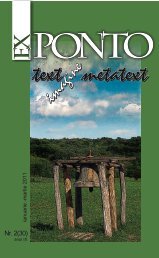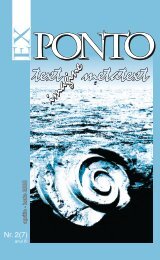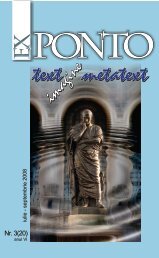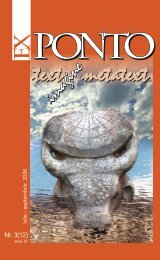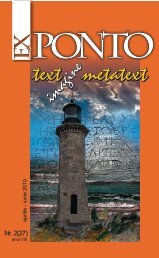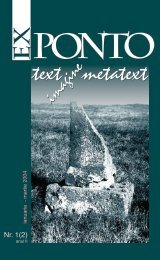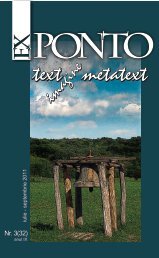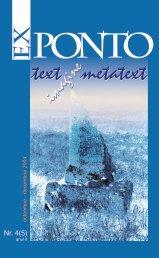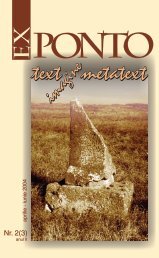Nr. 3 (24) anul VII / iulie-septembrie 2009 - ROMDIDAC
Nr. 3 (24) anul VII / iulie-septembrie 2009 - ROMDIDAC
Nr. 3 (24) anul VII / iulie-septembrie 2009 - ROMDIDAC
Create successful ePaper yourself
Turn your PDF publications into a flip-book with our unique Google optimized e-Paper software.
which belongs to all three styles. 1) It is a foreground of a documentary which<br />
investigates anatomical details to produce a record of the real picture of a fetus,<br />
for the first time shown in a Romanian pellicle. 2) It is a pictorially impressive<br />
image in an art film, with a metaphoric reference to all the generations born<br />
between 1966 and 1989, who were sentenced to a life of no choices, on the<br />
one hand. On the other hand, it is a literary reference to one of the most famous<br />
samizdat poems by Ana Blandiana, entitled Children’s Crusade.<br />
Un întreg popor<br />
Nenãscut încã<br />
Dar condamnat la na[tere,<br />
Foetus lângã foetus,<br />
Un întreg popor<br />
Care n-aude, nu vede, nu în]elege.<br />
Dar înainteazã<br />
Prin trupuri zvârcolite de femei,<br />
Prin sânge de mame<br />
Neîntrebate.<br />
An entire people<br />
Unborn yet<br />
But still sentenced to birth,<br />
Fetus near fetus,<br />
An entire people<br />
Who does not hear, see, nor understand,<br />
But keeps moving<br />
Inside tormented bodies of women,<br />
Inside mothers’ blood,<br />
Unasked. (my translation)<br />
3) It is also the corpse at the end of the thriller in which the camera takes<br />
delight in revealing the disgusting aborted shape.<br />
Going back to the description of the documentary by Jack Ellis and Betsy<br />
McLane one may check that Mungiu’s 4 Months meets all the standards of the<br />
genre: “Documentaries distinguish themselves from fiction films through their<br />
subjects; purposes, viewpoints and approaches; forms; production methods<br />
and techniques; sorts of experiences they offer to the public” (2). The purpose<br />
of Mungiu’s film is evident: the spectator has to realize that such dramas really<br />
happened, that, although such episodes have not yet become part of the official<br />
history, they must be considered under the “crimes of the communist regime.”<br />
As for the viewpoint and approach, Mungiu’s declaration is self-explanatory:<br />
“I was born in 1968 and this makes me part of the baby boom that was<br />
generated in Romania because of this law from 1966 that banned abortion<br />
there. I always start from a true story, I don’t make up things, and I ran<br />
into this girl again that had told me this story some 15 years ago. And I<br />
had the revelation that for a generation that came into this world because<br />
abortion was banned, that would be a very relevant story.”<br />
Mungiu tells the story of his generation in an apparently objective manner.<br />
However, the camera assumes the partial “ubiquity ” of a Secret Police<br />
informant who often filled in the parts he/she did not witness directly. 5 The<br />
fact that Mungiu and Oleg Muthu, his partner and editor, chose to record the<br />
story according to a strategy which allowed them to emphasize the immobility of<br />
the eye-witness (camera/informant) and the limited mobility of the characters,<br />
who, although heard from another room, are not captured visually. Mungiu<br />
explained this aesthetic decision in an interview in Observatorul cultural<br />
∂Cultural Reporter] corroborating it with another series of tough decisions<br />
to cut symbolic and explanatory scenes: He cut the scene in which Gabi<br />
meets her father, which would have justified the girls determination to go on<br />
with the abortion, as well as the last scene of the snowflakes covering the<br />
dirty street of Bucharest. 6 The current final scene, the only one in which a<br />
character (Otilia) looks directly in the camera, acknowledges the presence<br />
of the Secret Police informant; there is no doubt that camera has played that<br />
EX PONTO NR.3, <strong>2009</strong><br />
159




